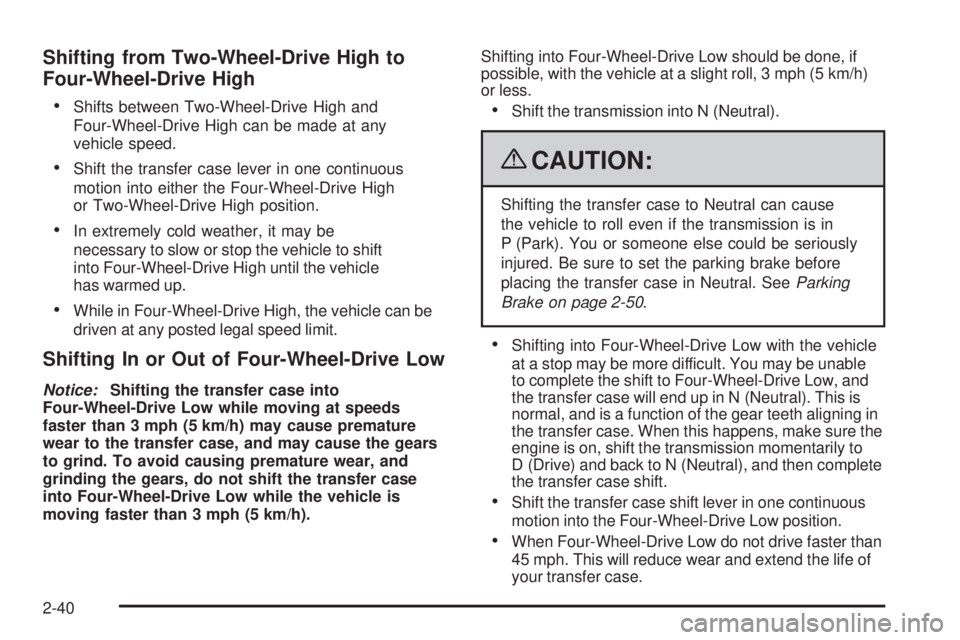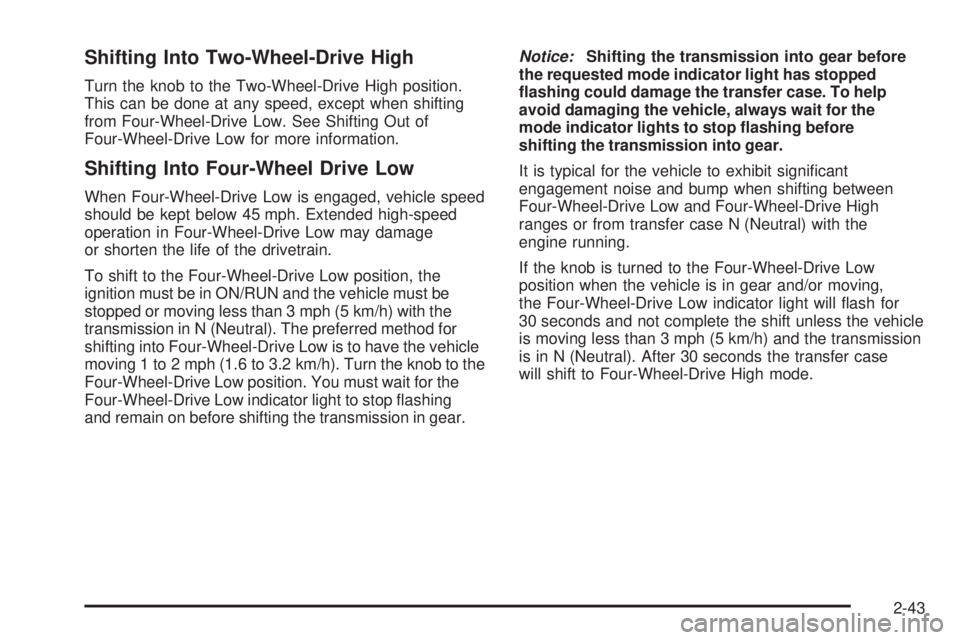Page 127 of 596

See “Range Selection Mode” later in this section.
P (Park):This position locks the rear wheels. It is the
best position to use when starting the engine because
the vehicle cannot move easily. When parked on a hill,
especially when the vehicle has a heavy load, you might
notice an increase in the effort to shift out of P (Park).
See Torque Lock (Automatic Transmission) under
Shifting Into Park on page 2-52for more information.
{CAUTION:
It is dangerous to get out of the vehicle if the shift
lever is not fully in P (Park) with the parking brake
�rmly set. The vehicle can roll.
Do not leave the vehicle when the engine is
running unless you have to. If you have left the
engine running, the vehicle can move suddenly.
You or others could be injured. To be sure the
vehicle will not move, even when you are on fairly
level ground, always set the parking brake and
move the shift lever to P (Park). SeeShifting Into
Park on page 2-52. If you are pulling a trailer,
seeTowing a Trailer on page 4-51. Heavy Duty 6-Speed Automatic Transmission
Shown (Light Duty 6 Speed Similar)
2-29
Page 132 of 596
Tow/Haul ModeVehicles with an automatic transmission have a tow/
haul mode. The tow/haul mode adjusts the transmission
shift pattern to reduce shift cycling, providing increased
performance, vehicle control, and transmission cooling
when towing or hauling heavy loads.
The selector button is located on the end of the shift
lever. Turn the tow/haul on and off by pressing the
button. When the tow/haul is on, a light on the
instrument panel cluster will come on.
SeeTow/Haul Mode Light on page 3-51for more
information.
Also see Tow Haul Mode underTowing a Trailer on
page 4-51for more information.
2-34
Page 133 of 596
Tow/Haul Mode (Allison Transmission®
or Hydra-Matic®6-Speed Automatic
Transmission)
Vehicles with an Allison or Hydra-Matic®6-speed
automatic transmission®have a tow/haul mode.
The tow/haul mode adjusts the transmission shift pattern
to reduce shift cycling, providing increased performance,
vehicle control, and transmission cooling when towing
or hauling heavy loads.
Turn the tow/haul mode on and off by pressing the
button, located on the end of the shift lever. When the
tow/haul is on, a light on the instrument panel cluster
will come on.
SeeTow/Haul Mode Light on page 3-51for more
information.
Also see “Tow Haul Mode” underTowing a Trailer on
page 4-51for more information.
2-35
Page 135 of 596

Four-Wheel Drive
If the vehicle has Four-Wheel Drive, you can send the
engine’s driving power to all four wheels for extra traction.
To get the most satisfaction out of Four-Wheel Drive, you
must be familiar with its operation. Read the following
before using Four-Wheel Drive. See the appropriate
text for the transfer case in the vehicle.
Notice:Driving on clean, dry pavement in
Four-Wheel-Drive High or Four-Wheel-Drive Low for
an extended period of time may cause premature
wear on your vehicle’s powertrain. Do not drive on
clean, dry pavement in Four-Wheel-Drive High or
Four-Wheel-Drive Low for extended periods of time.
While driving on clean dry pavement and during tight
turns, you may experience vibration in the steering
system.
If the vehicle has StabiliTrak
®, shifting into
Four-Wheel-Drive Low will turn Traction Control and
StabiliTrak
®off. SeeStabiliTrak®System on page 4-6.
Front Axle
The front axle engages and disengages automatically
when you shift the transfer case. Some delay for
the axle to engage or disengage is normal.
Manual Transfer Case
The transfer case shift lever is on the �oor to the right
of the driver. Use this lever to shift into and out of
Four-Wheel Drive.
A Four-Wheel Drive
indicator light comes
on when you shift into
four-wheel drive and
the front axle engages.
SeeFour-Wheel-Drive
Light on page 3-51.
2-37
Page 136 of 596

Some delay between shifting and when the indicator
light comes on is normal.
Recommended Transfer Case Settings
Driving ConditionsTransfer Case Settings
2m4m4nN
Normal YES
Severe YES
Extreme YES
Vehicle in Tow* YES
*SeeRecreational Vehicle Towing on page 4-45
Towing Your Vehicle on page 4-45
Notice:Driving on clean, dry pavement in
four-wheel drive for an extended period of time can
cause premature wear on the vehicle’s powertrain.
Do not drive on clean, dry pavement in Four-Wheel
Drive for extended periods of time.
4
n(Four-Wheel-Drive Low):This setting also engages
the front axle and delivers extra torque. You may never
need Four-Wheel-Drive Low. It sends maximum power to
all four wheels. You might choose Four-Wheel-Drive Low
if you are driving off-road in deep sand, deep mud, deep
snow, and while climbing or descending steep hills.If the vehicle has StabiliTrak
®, shifting into
Four-Wheel-Drive Low will turn Traction Control and
StabiliTrak
®off. SeeStabiliTrak®System on page 4-6.
A parking brake symbol
is located next to the
N (Neutral) symbol as a
reminder to set the parking
brake before shifting the
transfer case into
N (Neutral).
{CAUTION:
Shifting the transfer case to Neutral can cause
the vehicle to roll even if the transmission is in
P (Park). You or someone else could be seriously
injured. Be sure to set the parking brake before
placing the transfer case in Neutral. SeeParking
Brake on page 2-50.
2-38
Page 138 of 596

Shifting from Two-Wheel-Drive High to
Four-Wheel-Drive High
Shifts between Two-Wheel-Drive High and
Four-Wheel-Drive High can be made at any
vehicle speed.
Shift the transfer case lever in one continuous
motion into either the Four-Wheel-Drive High
or Two-Wheel-Drive High position.
In extremely cold weather, it may be
necessary to slow or stop the vehicle to shift
into Four-Wheel-Drive High until the vehicle
has warmed up.
While in Four-Wheel-Drive High, the vehicle can be
driven at any posted legal speed limit.
Shifting In or Out of Four-Wheel-Drive Low
Notice:Shifting the transfer case into
Four-Wheel-Drive Low while moving at speeds
faster than 3 mph (5 km/h) may cause premature
wear to the transfer case, and may cause the gears
to grind. To avoid causing premature wear, and
grinding the gears, do not shift the transfer case
into Four-Wheel-Drive Low while the vehicle is
moving faster than 3 mph (5 km/h).Shifting into Four-Wheel-Drive Low should be done, if
possible, with the vehicle at a slight roll, 3 mph (5 km/h)
or less.
Shift the transmission into N (Neutral).
{CAUTION:
Shifting the transfer case to Neutral can cause
the vehicle to roll even if the transmission is in
P (Park). You or someone else could be seriously
injured. Be sure to set the parking brake before
placing the transfer case in Neutral. SeeParking
Brake on page 2-50.
Shifting into Four-Wheel-Drive Low with the vehicle
at a stop may be more difficult. You may be unable
to complete the shift to Four-Wheel-Drive Low, and
the transfer case will end up in N (Neutral). This is
normal, and is a function of the gear teeth aligning in
the transfer case. When this happens, make sure the
engine is on, shift the transmission momentarily to
D (Drive) and back to N (Neutral), and then complete
the transfer case shift.
Shift the transfer case shift lever in one continuous
motion into the Four-Wheel-Drive Low position.
When Four-Wheel-Drive Low do not drive faster than
45 mph. This will reduce wear and extend the life of
your transfer case.
2-40
Page 139 of 596

Shifting In or Out of Neutral
1. With the vehicle running and the engine at an idle
set the parking brake.
2. Place the transmission into N (Neutral).
Shift the transfer case in one continuous motion into or
out of the N (Neutral) position.
Electronic Transfer Case
The transfer case knob is
located next to the
steering column.
Use the dial to shift into and out of four-wheel drive.
Recommended Transfer Case Settings
Driving ConditionsTransfer Case Settings
2m4m4nN
Normal YES
Severe YES
Extreme YES
Vehicle in Tow* YES
*SeeRecreational Vehicle Towing on page 4-45
Towing Your Vehicle on page 4-45
You can choose among four driving settings:
Indicator lights in the dial show which setting you are in.
The indicator lights will come on brie�y when you turn on
the ignition and one will stay on. If the lights do not come
on, you should take the vehicle to your dealer/retailer
for service. An indicator light �ashes while shifting the
transfer case and remains illuminated when the shift is
complete. If for some reason the transfer case cannot
make a requested shift, it will return to the last chosen
setting.
2-41
Page 141 of 596

Shifting Into Two-Wheel-Drive High
Turn the knob to the Two-Wheel-Drive High position.
This can be done at any speed, except when shifting
from Four-Wheel-Drive Low. See Shifting Out of
Four-Wheel-Drive Low for more information.
Shifting Into Four-Wheel Drive Low
When Four-Wheel-Drive Low is engaged, vehicle speed
should be kept below 45 mph. Extended high-speed
operation in Four-Wheel-Drive Low may damage
or shorten the life of the drivetrain.
To shift to the Four-Wheel-Drive Low position, the
ignition must be in ON/RUN and the vehicle must be
stopped or moving less than 3 mph (5 km/h) with the
transmission in N (Neutral). The preferred method for
shifting into Four-Wheel-Drive Low is to have the vehicle
moving 1 to 2 mph (1.6 to 3.2 km/h). Turn the knob to the
Four-Wheel-Drive Low position. You must wait for the
Four-Wheel-Drive Low indicator light to stop �ashing
and remain on before shifting the transmission in gear.Notice:Shifting the transmission into gear before
the requested mode indicator light has stopped
�ashing could damage the transfer case. To help
avoid damaging the vehicle, always wait for the
mode indicator lights to stop �ashing before
shifting the transmission into gear.
It is typical for the vehicle to exhibit signi�cant
engagement noise and bump when shifting between
Four-Wheel-Drive Low and Four-Wheel-Drive High
ranges or from transfer case N (Neutral) with the
engine running.
If the knob is turned to the Four-Wheel-Drive Low
position when the vehicle is in gear and/or moving,
the Four-Wheel-Drive Low indicator light will �ash for
30 seconds and not complete the shift unless the vehicle
is moving less than 3 mph (5 km/h) and the transmission
is in N (Neutral). After 30 seconds the transfer case
will shift to Four-Wheel-Drive High mode.
2-43